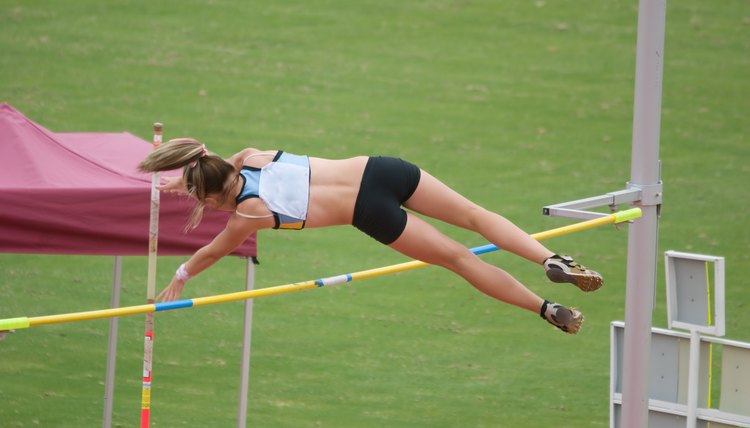Exercises for Pole Vaulting

A combination of gymnastics, weightlifting, sprinting, and jumping, pole vaulting is one of the most technically demanding events in athletics. Pole vaulters must be fast, powerful, strong, agile, and brave to succeed in this challenging and sometimes dangerous sport. There are a variety of exercises you can choose from to help you become a better pole vaulter.
The Snatch
The snatch is one of the Olympic lifts, and uses the body as a single synergistic unit, much like pole vaulting does. To perform the snatch, stand over a barbell with your toes under the bar. Bend down and grasp the bar with a wide -- around one and a half shoulder-widths apart -- overhand grip. Squat down so your hips are below your shoulders, and your arms are straight. Rapidly extend your hips and knees to pull the bar off of the ground, making sure to keep your lower back straight. Pull with your arms as the bar approaches waist height. Bend your knees to duck under the bar and catch it above your head. Stand up and hold this Y-shaped position for a moment before lowering the weight to the floor and repeating. Because such Olympic lifts are technically demanding, it’s a good idea to get some professional instruction to learn them properly.
The Push Press
To develop whole-body pushing power, stand with your feet shoulder-width apart, holding a barbell across your shoulders. Your hands should be facing forward and slightly wider than shoulder width. Push your elbows forward so that your upper arms are parallel to the floor. Bend your knees and descend into a quarter-squat position. Extend your hips and knees and drive the weight overhead by pushing with your arms. Hold the bar overhead for a second or two before lowering it back to your shoulders and repeating.
Band Sprints
To develop your acceleration, secure a strong exercise band to a sturdy hip-high anchor and attach the other end around your waist. With your back to the anchor, sprint away until the band stops your forward momentum. Resist the pull of the band and walk backwards until the band goes slack, then repeat. This exercise should only be performed with heavy-duty exercise bands made for this type of exercise.
Feet to Bar Hanging Leg Raises
Strong abdominal muscles are vital in pole vaulting, and this exercise closely simulates the action of getting your feet up and ready to clear the bar. Hang from a sturdy chin-up bar. Your arms, body and legs should be straight. Keeping your feet straight, lift your feet up until they touch your hands and your body forms a pike position. At this point, pull with your arms and extend your hips so that your body is fully inverted. Keeping under control, lower your body back to a full stretch and repeat. This exercise can be made easier by keeping your knees bent or more challenging by wearing ankle weights.
Towel Chin-Ups
A strong grip and strong back muscles go hand-in-hand in pole vaulting; this exercise will develop both. Loop a hand towel over each end of a chin-up bar. Grasp the ends of the towels in each hand and hold them tight. Starting with elbows extended, use your arms to pull your body up as high as you can while maintaining a strong grip on the towels at all times. Slowly lower back down and repeat. The thicker the towels, the more demanding this exercise is for your gripping muscles.
References
- High-Performance Sports Conditioning; Bill Faran
- Essentials of Strength Training and Conditioning; National Strength and Conditioning Association
- Designing Resistance Training Programs; Steven Fleck and William Kraemer
Writer Bio
Patrick Dale is an experienced writer who has written for a plethora of international publications. A lecturer and trainer of trainers, he is a contributor to "Ultra-FIT" magazine and has been involved in fitness for more than 22 years. He authored the books "Military Fitness", "Live Long, Live Strong" and "No Gym? No Problem!" and served in the Royal Marines for five years.
